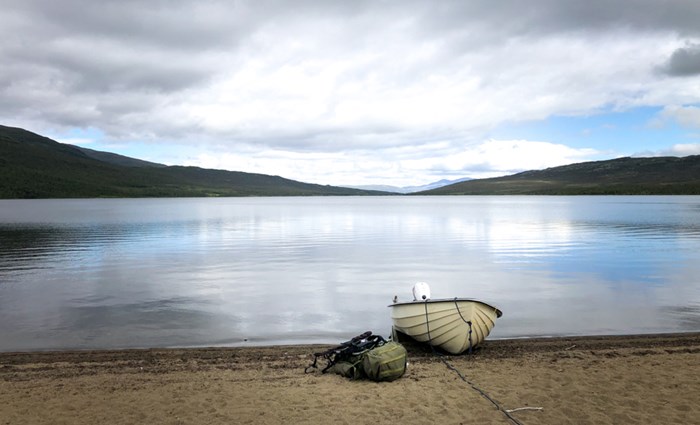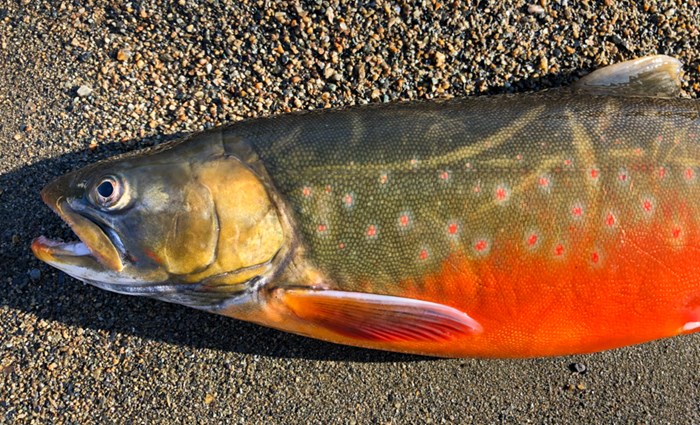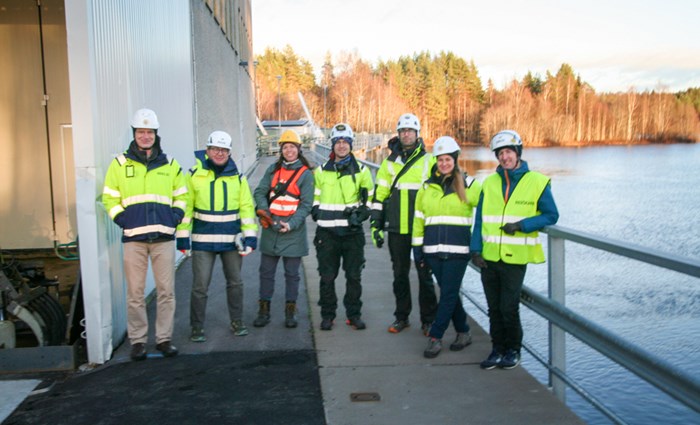Karin Nilsson
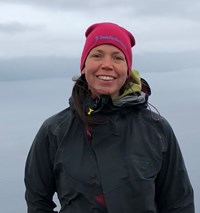
Presentation
I am a researcher at the Department of Wildlife, Fish, and Environmental Studies at SLU, Umeå. Most of my work concerns aquatic food webs and fish populations in particular. I am especially interested in the importance of different life stages - the fact that animals grow and develop during their lives - and what implications that has for population and community dynamics.
I have several projects connected to hydropower, one focusing on how we can improve passage efficiency for downstream migrating fish and the importance of respawning fish for populations. Another involves modeling how mitigation measures affect fish populations. Another theme is climate change and how it affects food webs and species interactions in northern lakes, with an extra focus on char and trout. I am a resource and contact person for modelling at the department.
Teaching
I am very enthusiastic about teaching and I have been teaching on a variety of courses, ranging from basic to advanced level. Currently, I am the course leader for Scientific theory and methods as well as Skogsskötsel och naturvårdsbiologi. I am also participating in a number of other courses, including Fiskevård, Fish Ecolgy, Fish and wildlife management, Fish and wildlife census techniques, and Applied Population Ecology.
If you are interested in writing a candidate or master thesis there is information on the department page - for example one project on how minnows affect brown trout and Arctic charr. But there may also be additional opportunities in connection to my research projects, for example in upcoming projects concerning the effects of fish farming and forestry on lake food webs.
Research
5 ongoing projects are listed below, while I also work on projects addressing food web effects of oligotrophication in the mountain chain, terrestrial – aquatic linkages (with an upcoming project on how/if forestry affects lake food webs), invasion of fish species, food web stability, and the evolution of polymorphism. Since our Department home page is being re-organized, I have added some information below instead of on project specific pages.
Threats to Arctic charr - species interactions and climate change.
In this project, we investigate critical factors that affect Artic charr, using field sampling, historical data and population models. The overall aims of the project are to determine why Arctic charr (Salvelinus alpinus) is declining in northern lakes and to develop management strategies for the preservation and sustainable use of Arctic charr populations.
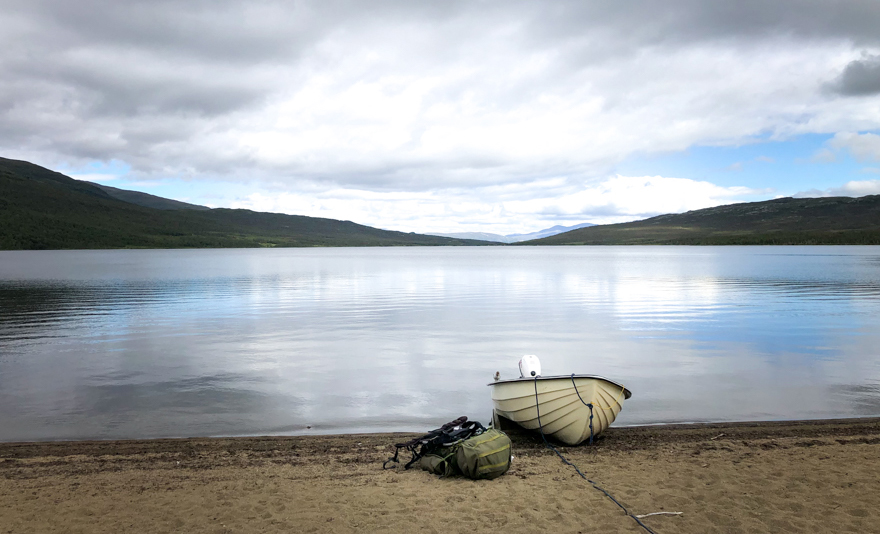
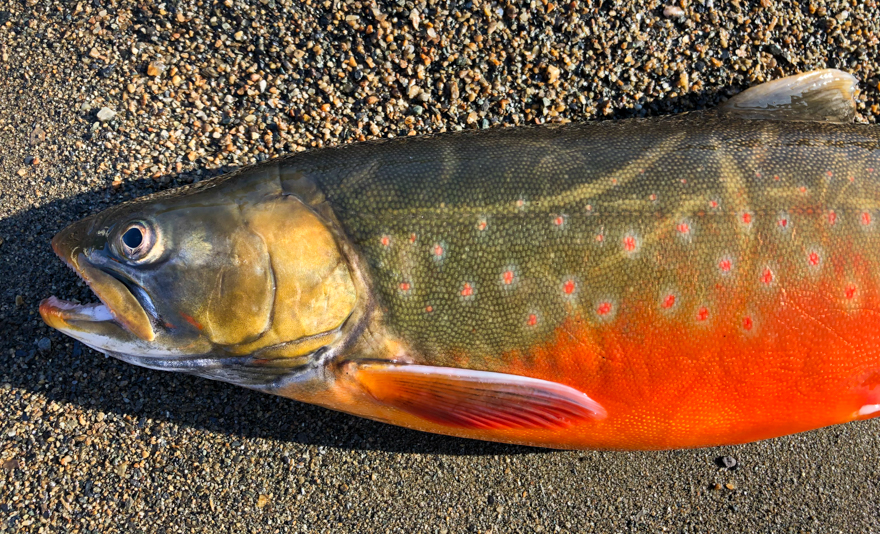
Arctic charr caught in a mountain lake in the Abisko area.
Photo: Karin Nilsson
We are investigating if and why Artic charr populations are declining in the presence of brown trout (Salmo trutta). Mountain lakes sampled in the past are being re-surveyed and local knowledge from interviews is used to assess what changes occur and how they differ between lake types. We identify critical species interactions and environmental factors that determine the distribution and population characteristics of Arctic charr, and relate these to ongoing environmental change. Existing databases, with patterns in species occurrences, densities and population structures are used. Furthermore, we use size and season- specific growth patterns to elucidate mechanisms behind how and why Arctic charr populations change over time and differ between lakes. Finally, we use mathematical modeling to investigate how competition and predation from brown trout affects charr populations in different types of lakes, and how different harvest strategies should be adapted depending on if brown trout is present or not.
The project is performed in collaboration with county boards, Sami villages, local fishermen and other scientists, including Kerstin Holmgren at SLU Aqua and Pär Byström at Umeå University. This work also links to a project on polymorphism in charr, led by Gunnar Öhlund. Post Doc Renee van Dorst is working on this project (https://internt.slu.se/en/cv-originals/renee-van-dorst/).
Increasing the passage efficiency for re-spawners: knowledge and technical solutions.
In this project, we find novel methods to improve the downstream migration of salmon and trout and investigate the importance of re-spawners for migrating populations.
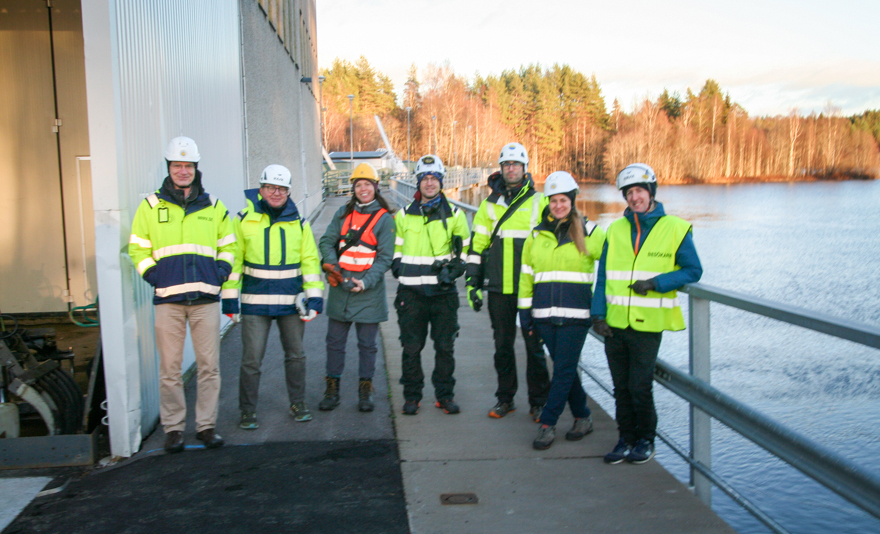
Here we are visiting Edforsen in Klarälven to
figure out how we can guide downstream
migrating salmon. Photo: Karin Nilsson
Summary: Swedish hydropower will soon face relicensing processes in relation to new modern environmental standards. In light of this we have identified a knowledge gap regarding downstream passage of large fish, and in particular for salmonid post-spawners. We do not know much about the behavior and migration of post-spawners, nor do we have quantitative information about their importance to populations and how to attain functional passage solutions. To address this, we are testing technical solutions for guiding fish during downstream migration, using both field experiments and experiments conducted in a large flume. We also collect new data from salmon and trout populations and analyze existing data to evaluate the significance of repeat spawners. Finally, we use population models to evaluate the role of repeat spawners and to objectively analyze the effect of remedial measures aimed at improving the status and migration opportunities for salmonid populations. Post Doc Georgia Macaulay works on this project.
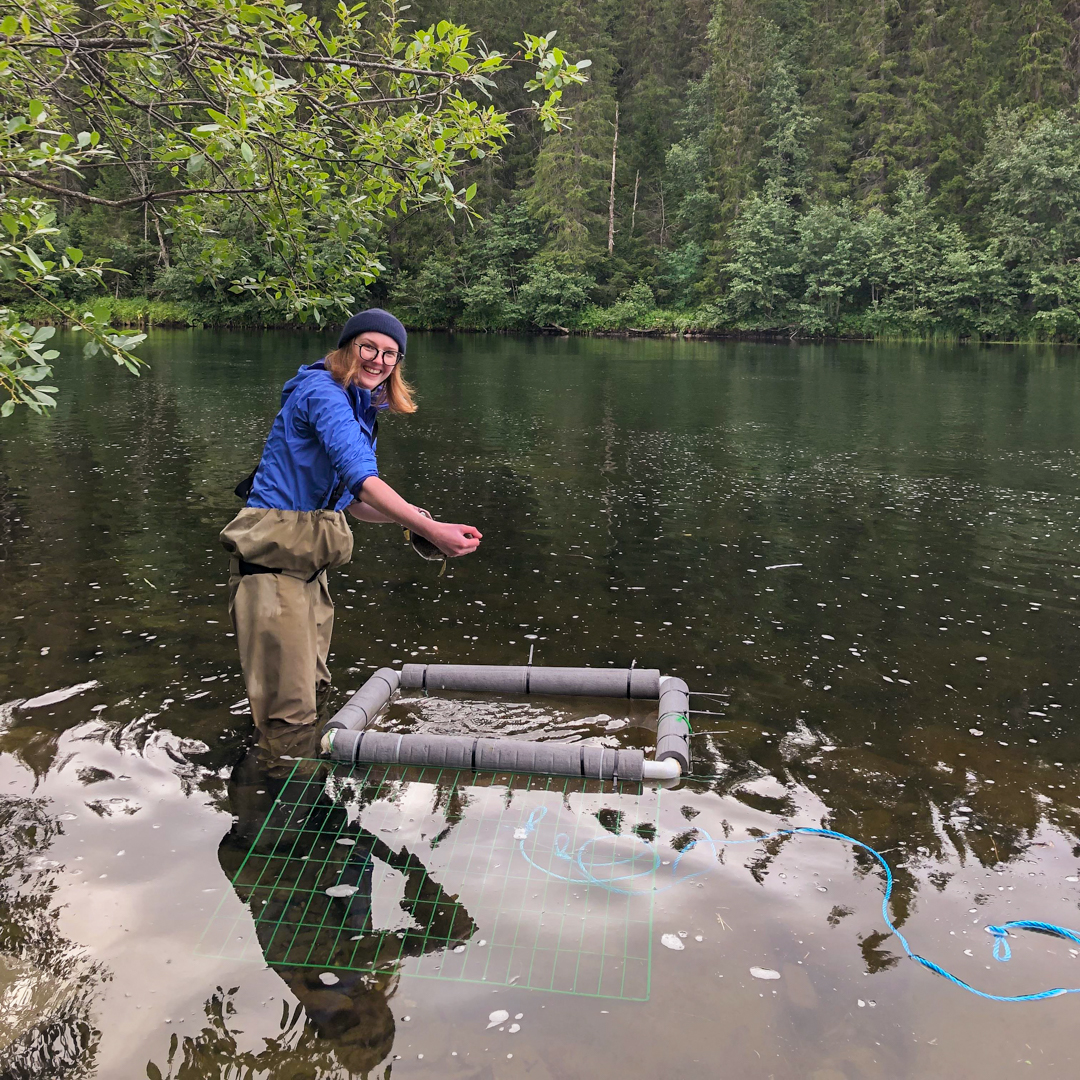
Here Georgia is releasing a tagged brown trout in the river Dammån (Jämtland).
Photo: Karin Nilsson
Implementing science-based model tools in the revision of Swedish hydropower plant licenses - the importance of habitat and connectivity.
In this project, we implement population models to assess how useful they are as tools in management decisions. The project page is under construction.
New project: Effects of aquaculture on aquatic food webs in northern freshwater ecosystems
We have received funding from the Kamprad Foundation to study how fish farming affects the aquatic food webs in northern lakes. Swedish open-cage fish farming is mainly conducted in large oligotrophic lakes regulated for hydropower. We will study how natural fish communities and the biodiversity of key groups of invertebrates respond to aquaculture. The project consists of a large collaborative network that will address a variety of questions. Post Doc Maria Myrstener works on this project.
Upcoming project: Recreating shallow bottom habitats - a measure benefiting biodiversity and sustainable energy production in regulated lakes?
We have recently received funding from the Swedish Energy Agency for a new exciting project. A PhD position wil become available in the project (likely late 2024).
Background
Current position, from March (2020): Researcher at the Department of Wildlife, Fish and Environmental Studies at the Swedish University of Agricultural Sciences in Umeå.
March (2018) – February (2020) Post Doc at Umeå University, studying Artic charr in a changing climate, working with Pär Byström at the Department of Ecology and Environmental Science.
December (2017) –February (2018) Research project, 3 months as part of the Biodiversity and Resilience project (BiRN, Canada). Working on diversity questions using fish community databases from Japan, Ontario and Sweden.
March – May 2016 Research project focusing on invasive fish species at the Japanese National Institution of Environmental Sciences, Tsukuba Japan. Together with Taku Kadoya. Financed by a scholarship from the Swedish KVA to K.N.
October 2014 –February 2016 Research engineer at the Department of Ecology and Environmental Science, Umeå University, financed by a repatriation grant from the Swedish Research Council to K.N.
October 2012-September 2014: Post Doc at the University of Guelph, Canada, modelling food web dynamics and studying harvest effects on lake trout populations, working with Kevin McCann. Financed by the Swedish Research Council to K.N.
2012 March-September: Post Doc at the Swedish University of Agricultural Sciences, Umeå, modelling competition and recruitment in salmonid populations, working with Kjell Leonardsson.
2011 PhD in Ecology: Effects of size-dependent predation and competition on population and community dynamics. Supervisor: Professor Lennart Persson Department of Ecology and Environmental Science, Umeå University.
Selected publications
Effects of habitat-specific primary production on fish size, biomass and production in northern oligotrophic lakes (Ecosystems 2021)
Norman S, Nilsson KA, Klaus M, Seekell D, Karlsson J & Byström P.
Ecological speciation in European whitefish is driven by a large-gaped predator. Öhlund G, Bodin M, Nilsson KA, Öhlund S-O, Mobley K, Hudson B, Gregg A, Peedu M, Brännström Å, Bartels P, Praebel K, Hein C, Johansson P & Englund GE (Evolution Letters 2020)
Homogenization of Canadian lakes: does gamefish movement outpace climate change? Cazelles K., Bartley T., Guzzo M.M., Brice M., MacDougall A.S., Bennett J., Esch E., Firn J., Kadoya T., Kelly J., Matsuzaki S., McCune J., Nilsson K.A. & McCann K.S. (Global Change Biology 2019)
Uneven global distribution of food web studies under climate change
Erin K. Cameron, Maja K. Sundqvist, Sally A. Keith, Paul J. Caradonna, Erik A. Mousing, Karin A. Nilsson, Daniel B. Metcalfe, and Aimee T. Classen
Ecosphere (2019)
Context-dependent interactions and the regulation of richness in freshwater fish. MacDougall A.S., Harvey E., McCune J., Nilsson K.A., Bennett J., Firn J., Bartley T., Grace J., Kelly J., Tunney T., McMeans B., Matsuzaki I., Kadoya T., Esch E.,Cazelles K., Lester N., & McCann K.S. Nature Communications (2018)
Interaction strength and stability in stage-structured food webs modules
Karin A. Nilsson, Kevin S. McCann and Amanda L. Caskenette
Oikos (2018)
Interaction strength revisited - clarifying the role of energy flux for food web stability. Karin A. Nilsson and Kevin S. McCann. Theoretical Ecology 2016 (9:59)
Refuge availability and within-species differences in cannibalism determine population variability and dynamics. Karin A. Nilsson and Lennart Persson
Ecosphere 2013 (4(8):100)
Guppy populations differ in cannibalistic degree and adaption to structural environments. Karin A. Nilsson, Sofi Lundbäck, Alexandra Postavnicheva-Harri and Lennart Persson. Oecologia 2011 (167:391–400)
Experimental evidence for emergent facilitation: Promoting the existence of an invertebrate predator by killing its prey. Magnus Huss and Karin A. Nilsson
Journal of Animal Ecology 2011 (80: 615–621)
Complete compensation in fecundity and stage-specific biomass in response to harvesting in a Daphnia-algae system. Karin A. Nilsson, Lennart Persson and Tobias van Kooten. Journal of Animal Ecology 2010 (79:871-878)
Invasion success depends on invader body size in a size-structured mixed predation–competition community. Arne Schröder, Karin A. Nilsson, Lennart Persson, Tobias van Kooten and Birte Reichstein Journal of Animal Ecology 2009 (78:1152-1162)
Reports
Modellering av fiskvägars betydelse för fiskbestånden - verktyg för att utvärdera åtgärdsförslag. Kjell Leonardsson and Karin A. Nilsson. Energiforsk rapport (2021)
Book chapters
Including the life cycle in food webs. Karin A. Nilsson, Amanda L. Caskenette, Christian Guill, Martin Hartvig, Floor H. Soudijn. In Food webs; Science with impact eds. Peter de Ruiter, John Moore (2017)
